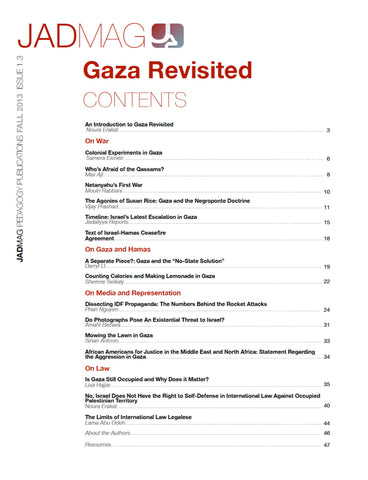JADMAG Issue 1.3 "Gaza Revisited"
Description
Gaza Revisited
Edited by Noura Erakat
In November 2012, Israel began an aerial bombing campaign against the Gaza Strip that lasted eight gruesome days. Even in its first hours, and before its full magnitude was known, the military campaign sparked urgency amongst observers because of the memory it evoked. In winter 2008/09, Israel conducted a twenty-two day military offensive against the besieged territory. The offensive, infamously known as Operation Cast Lead, killed some 1,300 Palestinians including 280 children, and destroyed twenty-nine schools, sixty police stations, thirty mosques, and 2,400 homes. Thirteen Israelis were killed during the onslaught including three civilians, and four soldiers who were killed by friendly fire. Israel’s military attack unleashed an unprecedented amount of lethal force that raised a slew of moral, political, and legal controversies. Four years later, observers braced themselves for a similar campaign. Operation Pillar of Cloud was not as devastating or long-lasting as its most recent predecessor, but it marked an equally significant juncture in the history of the Palestinian-Israeli conflict.
This pedagogy publication examines the November 2012 military offensive and unpacks historical legacies, legal questions, media portrayals, and political considerations. In doing so, the publication helps create a context for the attack and considers possibilities for the future of the conflict and the balance of power in the Middle East more generally.
The contributions aim to provide context for a conflict that becomes acutely narrow during recurring instances of military confrontation. The challenge is to instill this context in policy, media, legal, and popular discourse in order to move beyond the absurd parity ascribed to parties at war. For one, they are not equal. More importantly, the structural violence of occupation, siege, and de-development never ceases to afflict Palestinians even when their skies are free of the humming of drones.
Table of Contents
Introduction
An Introduction to Gaza Revisited, pg. 3
by Noura Erakat
Articles
Colonial Experiments in Gaza, pg. 6
by Sameera Esmeir
Who's Afraid of the Qassams, pg. 8
by Max Ajl
Netanyahu's First War, pg. 10
by Mouin Rabbani
The Agonies of Susan Rice: Gaza and the Negroponte Doctrine, pg. 11
by Vijay Prashad
Timeline: Israel's Latest Escalation in Gaza, pg. 15
by Jadaliyya Reports
Text of Israel-Hamas Ceasefire Agreement, pg. 18
A Separate Piece?: Gaza and the "No-State-Solution", pg. 19
by Darryl Ll
Counting Calories and Making Lemonade in Gaza, pg. 22
by Sherene Seikaly
Dissecting IDF Propoganda: The Numbers Behind the Rocket Attacks, pg. 24
by Phan Nguyen
Do Photographs Pose An Existential Threat to Israel?, pg. 31
by Amahl Bishara
Mowing the Lawn in Gaza, pg. 33
by Sinan Antoon
African Americans for Justice in the Middle East and North Africe: Statement Regarding the Aggression in Gaza, pg. 34
Is Gaza Still Occupied and Why Does it Matter?, pg. 35
by Lisa Hajjar
No, Israel Does Not Have the Right to Self-Defense in International Law Against Occupied Palestinian Territory, pg. 40
by Noura Erakat
The Limits of International Law Legalese, pg. 44
by Lama Abu Odeh
About the Authors
About the Authors, pg. 46
Pedagogical Resources
Annotated Bibliography, pg. 47

Introduction
In November 2012, Israel began an aerial bombing campaign against the Gaza Strip that lasted eight gruesome days. Even in its first hours, and before its full magnitude was known, the military campaign sparked urgency amongst observers because of the memory it evoked. In winter 2008/09, Israel conducted a twenty-two day military offensive against the besieged territory. The offensive, infamously known as Operation Cast Lead, killed some 1,300 Palestinians including 280 children, and destroyed twenty-nine schools, sixty police stations, thirty mosques, and 2,400 homes. Thirteen Israelis were killed during the onslaught including three civilians, and four soldiers who were killed by friendly fire. Israel’s military attack unleashed an unprecedented amount of lethal force that raised a slew of moral, political, and legal controversies. Four years later, observers braced themselves for a similar campaign. Operation Pillar of Cloud was not as devastating or long-lasting as its most recent predecessor, but it marked an equally significant juncture in the history of the Palestinian-Israeli conflict.
This pedagogy publication examines the November 2012 military offensive and unpacks historical legacies, legal questions, media portrayals, and political considerations. In doing so, the publication helps create a context for the attack and considers possibilities for the future of the conflict and the balance of power in the Middle East more generally.
The contributions aim to provide context for a conflict that becomes acutely narrow during recurring instances of military confrontation. The challenge is to instill this context in policy, media, legal, and popular discourse in order to move beyond the absurd parity ascribed to parties at war. For one, they are not equal. More importantly, the structural violence of occupation, siege, and de-development never ceases to afflict Palestinians even when their skies are free of the humming of drones.
For more information, go to the teaching guide.







